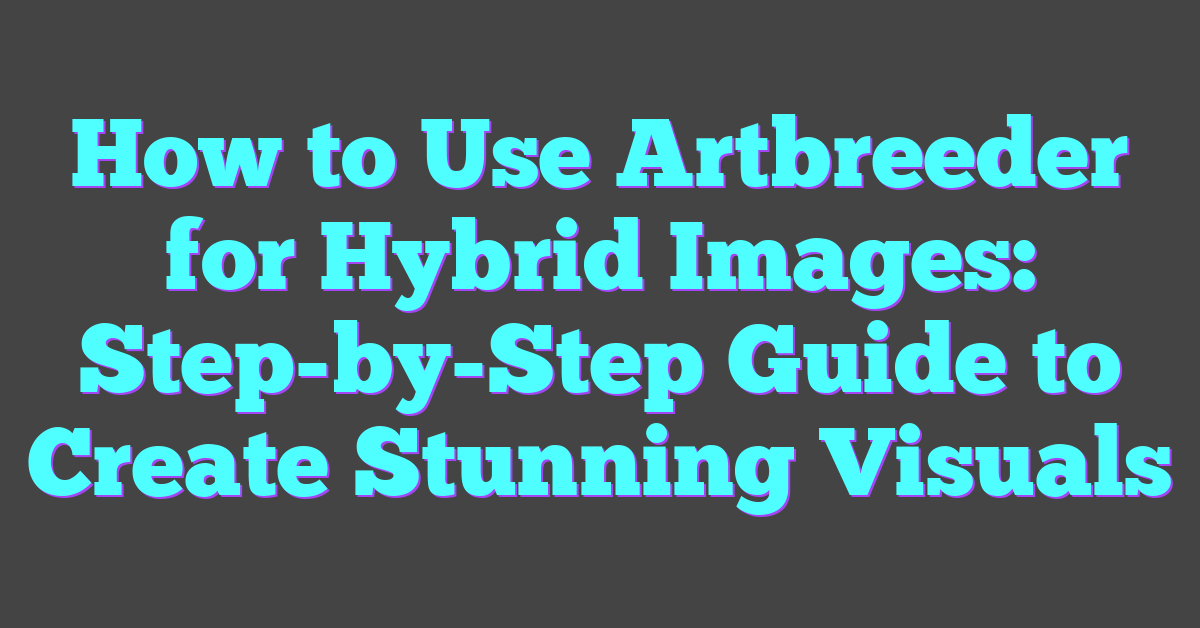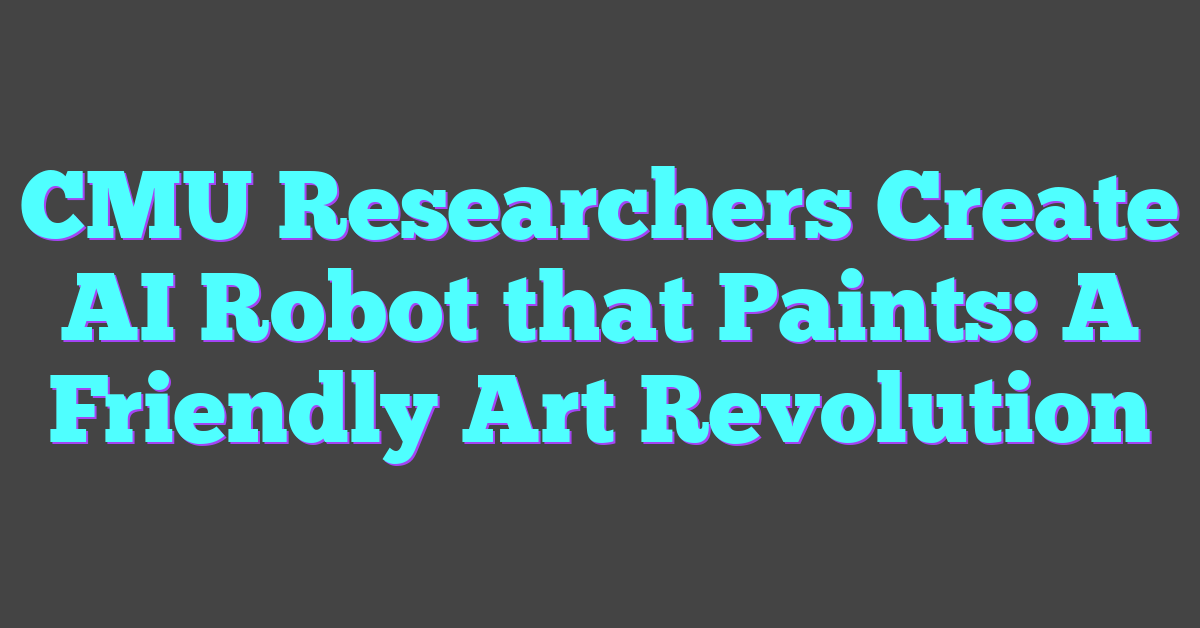Creating hybrid images that blend elements of art and imagination has never been easier, thanks to Artbreeder. When I first discovered this platform, I was amazed by how effortlessly it lets you combine features, tweak details, and bring unique creations to life. It’s like having a digital canvas that evolves with your ideas.
If you’ve ever wanted to experiment with merging faces, landscapes, or even abstract concepts, Artbreeder is your playground. You don’t need to be a professional artist or tech wizard to dive in—it’s intuitive and fun. In this guide, I’ll walk you through the basics of using Artbreeder to craft stunning hybrid images that are as unique as your creativity.
What Is Artbreeder?
Artbreeder is a creative platform powered by AI and machine learning. It enables users to blend and modify visual elements, offering unique opportunities for generating hybrid images. By leveraging generative adversarial networks (GANs), it transforms user inputs into visually stunning artworks.

Overview Of Artbreeder Features
Artbreeder utilizes an intuitive interface for creating and editing images. Users can manipulate genetic traits like age, gender, and emotion on portraits, adjust landscapes’ color and style, or combine unrelated categories for abstract results.
- Image Splicing: Merge multiple images seamlessly to form hybrids. For instance, mix two portraits for a unique look.
- Slider Controls: Adjust specific aspects like brightness, sharpness, or mood elements quickly.
- Diverse Categories: Explore art types, from landscapes to anime characters, each fully customizable.
- Collaborative Library: Share results in a common database and refine others’ creations.
Key Benefits For Creating Hybrid Images
Artbreeder offers distinct advantages for hybrid image generation. Modeling AI art reduces complexity by streamlining tasks usually requiring advanced design tools.
- Customization Ease: Modify attributes precisely without prior design experience.
- Creative Exploration: Experiment with ideas and see instant AI-generated outcomes.
- Accessible Technology: Produce professional-quality visuals using browser-based tools.
- Efficient Iteration: Test multiple options rapidly without manual intervention.
By combining AI precision with user creativity, Artbreeder redefines hybrid image creation.
Getting Started With Artbreeder
Using Artbreeder combines the power of AI with creativity, opening countless possibilities to craft hybrid images. To unlock its potential, understanding the setup process and interface is key.
Setting Up An Account
Creating an account is the first step to accessing Artbreeder’s features. Visit the Artbreeder website and select “Sign Up.” Enter an email, create a password, and confirm registration. After signing up, users gain access to image generation, customization tools, and the collaborative library.
For those who create content regularly, linking accounts like Google or Facebook simplifies login. Paid memberships also offer additional features, such as higher resolution downloads and advanced editing options.
Navigating The Interface
The Artbreeder interface is designed for simplicity, enabling quick familiarization. The main dashboard displays categories like “Portraits,” “Landscapes,” and “Anime,” each leading to specific art styles. Selecting a category provides access to sliders for altering traits like color, style, and composition.
At the top, users find tools for creating new images or uploading content. The “Explore” section highlights community creations and allows remixing other users’ work. For hybrid image creators, “Splice an Image” combines elements from multiple sources, showcasing AI-driven blending.
Tabs and sliders ensure efficient control of every image generation aspect, making the process smooth for artists and AI enthusiasts alike.
Creating Hybrid Images On Artbreeder
Using Artbreeder to create hybrid images allows me to combine my passion for AI with my love for content creation. It’s a seamless way to bring diverse elements together using advanced machine learning algorithms.
Choosing Base Images
Selecting compelling base images is the foundation of hybrid creation. I start by browsing Artbreeder’s extensive library, which offers categories like “Portraits,” “Landscapes,” and “Anime.” This library serves as a pool of creative inspiration and starting points. If I have specific ideas, I upload custom images to align my customizations with my vision. The AI processes each base image, enabling quick and precise edits.
Combining Features And Adjusting Parameters
Blending features is intuitive with Artbreeder’s genetic sliders. I select traits like age, gender, and facial emotions in portraits or manipulate environmental features in landscapes. For example, I merged two portraits by splicing their features, then fine-tuned parameters like skin tone and expression using sliders for control. Through AI guidance, adjustments remain consistent while maintaining a natural balance.
Exploring Style Customization Options
Style customization unlocks creative possibilities. I experiment with the “Genes” section to alter artistic attributes, such as realism and abstraction. With landscapes, I adjust lighting or introduce dream-like textures. In portraits, I modify artistic styles to create line-art effects or enhance photorealism. By layering these aesthetic enhancements, I tailor every hybrid image to express unique narratives that blend technology with artistry.
Tips And Tricks For Effective Hybrid Images
When using Artbreeder, precise experimentation and leveraging its full capabilities enhance your creations. Drawing on my passion for AI and content creation, I’ve gathered strategies to maximize the potential of hybrid imagery through this platform.
Utilizing Reference Images
I always start by selecting strong reference images. Artbreeder’s library provides a high-quality starting point, but using personal uploads offers unique flexibility. Mixing platform options with original content allows greater control over the creative outcome. For example, when merging portraits, I opt for base images with distinct facial traits like pronounced jawlines or unique eyes to avoid generic results.
Cropping and initial modifications help refine the base before blending. If I’m working on landscapes, I ensure the primary elements, like mountains or lighting conditions, align across references for a cohesive fusion. Combining consistent foundations improves AI outputs, reducing the need for repetitive fine-tuning.
Experimenting With Sliders And Attributes
Sliders are where the magic happens. Adjusting individual attributes like “Age,” “Ethnicity,” or “Mood” in portraits or “Color Intensity” in landscapes lets me fine-tune each detail. I move sliders incrementally to understand their effects, noting extreme settings often produce overly stylized results that blur artistic intent.
Layering adjustments across multiple sliders creates balance. For instance, I adjust both “Emotion” and “Contrast” simultaneously to achieve dynamic expressions in portraits. Experimentation with complementary settings—like blending “Warmth” and “Brightness” for landscapes—results in visually harmonious hybrids. Employing subtle tweaks ensures that no single trait dominates the image.
Understanding these tools deepens creative possibilities, turning Artbreeder into a collaborative partner rather than just a platform.
Common Challenges And How To Overcome Them
Using Artbreeder for hybrid images is an exciting process, but challenges can arise, particularly for users new to AI-driven image creation. Drawing from my expertise in artificial intelligence and machine learning, I’ll address some common issues and provide actionable solutions.
Addressing Unwanted Visual Artifacts
Unwanted artifacts, such as pixelation or distorted details, can appear when blending images. This often happens due to extreme adjustments in the genetic sliders or incompatible source images.
To minimize these issues, I recommend starting with high-quality base images that share similar resolutions or visual styles. Gradual adjustments to sliders, rather than extreme changes, often generate smoother results. If notable artifacts persist, users can splice images with cleaner elements or isolate problematic areas by tweaking specific traits (e.g., skin texture or background clarity). Testing multiple sources typically leads to better outputs with fewer inconsistencies.
Balancing Realism And Creativity
Striking a balance between realistic and stylized elements is a common hurdle, especially in portraits and landscape creations. Overemphasizing one trait, like abstraction, can detract from the image’s overall appeal.
To achieve equilibrium, I advise combining subtle, realistic traits with creative enhancements. For instance, blending a realistic base image with artistic flourishes (e.g., exaggerated colors or surreal lighting) often produces compelling results. Experimentation is key. By iteratively tweaking sliders for balance, users can maintain some grounded realism while exploring bold customization opportunities.
Creative Applications Of Hybrid Images
Artbreeder has versatile uses across creative fields, combining my passion for AI and content creation. Hybrid images can serve both personal exploration and professional development.
Personal And Professional Projects
Artbreeder offers endless opportunities for personal and professional projects. In academic applications, I use Artbreeder-generated hybrid images to enhance presentations on AI-driven creativity, demonstrating how machine learning enhances artistic workflows. For storytelling, I develop character concepts by blending unique traits, creating visual aids that enrich narratives and world-building.
In professional design, Artbreeder simplifies prototyping. When working on AI-based projects requiring visuals, I generate hybrid images for mockups or placeholders. This accelerates workflows without needing complex design software. Hybrid landscapes, for example, are valuable in UI concepts for gaming or interactive simulations.
Social Media And Portfolio Showcases
Artbreeder creations elevate online profiles and portfolio presentations. I use hybrid images to design distinctive avatars, banners, and thumbnails, turning content into visually striking assets. For instance, creating customized hybrid portraits allows me to visually represent themes in AI-related content, fostering stronger audience engagement.
Hybrid visuals also play a role in portfolios. Displaying Artbreeder creations in a web design portfolio showcases proficiency in leveraging generative AI tools, which resonates with clients or collaborators familiar with emerging technologies.
Conclusion
Artbreeder opens up a world of possibilities for creating unique hybrid images, blending creativity with the power of AI. Whether you’re an artist, designer, or just curious about experimenting with visuals, the platform makes the process approachable and fun. By combining intuitive tools with endless customization options, it encourages exploration and sparks inspiration.
I’ve found Artbreeder to be an incredible resource for turning imaginative ideas into reality. It’s not just about creating images—it’s about discovering new ways to express yourself and push creative boundaries. If you’re ready to dive in, Artbreeder is the perfect place to start.




